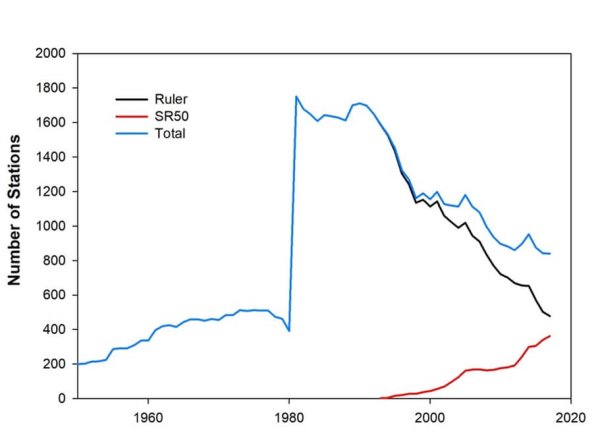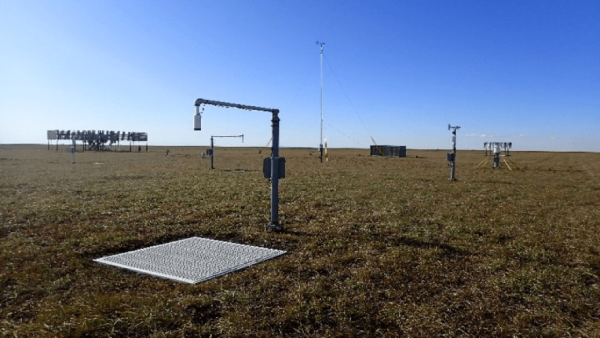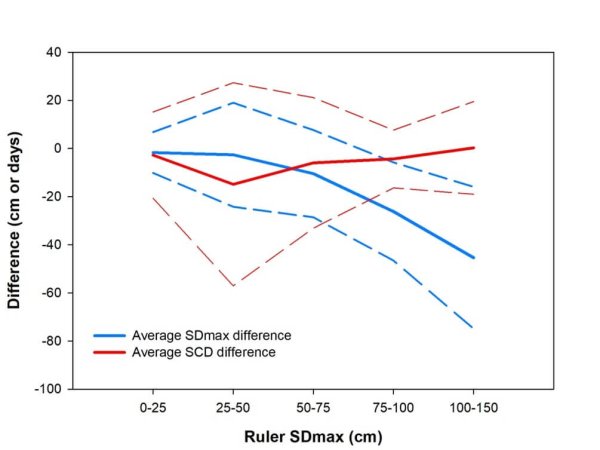
Declining numbers of stations and automation of surface snow depth observations pose important challenges for applications requiring long term consistent surface snow depth information over Canada
– By Ross D. Brown –
Environment and Climate Change Canada’s (ECCC) snow depth observing stations represent the primary surface snow depth observing network in Canada, providing real-time input on surface snow cover conditions that contributes to increased skill and reduced air temperature biases in forecast models. The archived data also have important downstream applications such as estimation of design ground snow loads analysis of snow cover impacts on ground heat transfer and permafrost, and assessment of variability and change in Canadian snow cover. These applications require long-term, consistent information on snow depth variations over time. However, this requirement is challenged by two phenomena: first, a rapid decline of approximately 50% in the number of sites measuring daily snow depth since 1995; second, an ongoing shift from manual to automated snow depth observations that represents a fundamental change in the way snow depth observations are made. Currently, about 50% of the total observing network uses an ultrasonic ranging sensor (‘SR50’), including more than 80% of the network above 55°N. Figure 1 shows the historical evolution of the number of stations in the network by measurement method.

To provide some context for Figure 1, regular daily ruler measurements of snow depth began in 1941 at principal observing stations with spatial coverage mainly confined to southern Canada until the mid-1950s when the synoptic station network expanded into the Arctic. Prior to 1941, snow depth observations were typically only made at the end of the month and at a relatively small number of sites. For the weather trivia buffs, the earliest recorded snow depth observation in the ECCC historical archives was made at Chaplin, Saskatchewan, in 1883. The manual observing network underwent a major expansion after 1980 when daily snow depth observations were initiated at volunteer climate stations, with a peak of over 1600 active stations during the 1981-1994 period. The protocol for manual ruler observations has remained essentially unchanged since 1941, with observers instructed to record the average of a series of measurements avoiding snowdrifts. Allowing the manual observer to select the number and location of measurement points introduces some subjectivity, but the averaging of these measurements helps capture the ‘typical’ local conditions.
The mid-1990s saw the start of a major effort to automate the ECCC surface observing network in response to declining budgets and network modernization: automation offers the potential for increasing network coverage in data-sparse areas and for providing potential all-weather quantitative data for time intervals of one hour or less to meet World Meteorological Organization requirements. The snow depth measurement sensor used in ECCC automated weather stations is based on a prototype developed by Dr. Barry Goodison of the Hydrometeorology Division of the Canadian Climate Centre in the early 1980s. The inspiration for the sensor came from a commercially available ultrasonic ranging kit from Polaroid Corporation that used the travel time of an acoustic signal from a reflecting surface to estimate the distance to the surface. The sensor went through several iterations during the late 1980s and early 1990s and officially went into service for ECCC in 1993 as the Campbell Scientific Sonic Ranger SR50, updated in 2007 to the more compact SR50A. Figure 2 shows a typical SR50 sonic sensor configuration above a fixed artificial target. The artificial target prevents the growth of vegetation under the sensor and provides a stable flat surface for reflecting the sonic pulse when there is little or no snow under the sensor. Various evaluations have demonstrated the sensor measures snow depth (directly under the sensor) with an error of less than 2 cm. However, the sensor can be unreliable during heavy snowfall or blowing snow events when the acoustic signal is obscured.

The key difference between manual and SR50 observations is that the latter is made at a single fixed point, while the former includes some attempt at spatial averaging by the observer. The two methods should give similar results where the snow cover is relatively homogenous, but this is rarely the case in windy environments, such as the Arctic and Prairies where the snowpack is shallow and subject to frequent drifting and scouring. In these environments, acoustic sensors are faced with a sampling problem (how can a single point observation be considered “representative”?), plus issues with unreliable readings during blowing snow conditions. In the early 2000s ECCC attempted to address the sampling issue with the implementation of three closely-distributed SR50 sensors, which is the current standard at all ECCC autostations. However, the process of how to operationally combine the information from the three sensors has not yet been defined, and only data from one arbitrarily chosen sensor is currently reported. A comparison of manual ruler observations with nearby autostations equipped with SR50 sensors by Brown et al. (2021) showed that sonic sensors observed similar numbers of days with snow on the ground, but systematically underestimated manually reported snow depths, with the amount of the underestimation increasing with depth (Fig. 3). The systematic difference between the two measurement methods was taken into account by Brown et al. (2021) in an updated assessment of surface snow cover trends in Canada. The datasets developed for this analysis including quality controlled historical daily snow depth station series can be accessed via the link here.

Having spent several decades working with and agonizing over ECCCs snow depth data, here are several recommendations that would greatly help ECCC better meet the needs of users who need consistent, long-term, reliable snow depth data. First, an urgent effort is needed to improve the quality of the sonic sensor data archived by ECCC. Fully utilizing the triple sensor configuration is an important first step (i.e. archiving and making available the hourly observations from all three sensors), along with ensuring that the siting of the three sensors is optimized to provide representative estimates of the snow depth in the vicinity of the observing site. This is especially important in exposed, windy environments with strong spatial variability in snow distribution. Second, more effort is needed to carry out quality control of the observations included in the ECCC climate archive; this includes additional data consistency checks (the observations from the three sensors would greatly facilitate this process) and the archiving of key metadata, such as measurement method history, along with the data so that users are aware of the nature of the measurements they are working with. Third, site information should be readily available including photos showing the location of the sensors under a variety of snow cover conditions. Finally, there is a need to identify (and protect) stations with long-term, consistent manual snow depth measurements. These stations, of which there are currently less than 100, represent the reference for documenting the snow depth response to climate change, and their importance for this and other needs cannot be overstated.
Note: the link to the snow data provided in the published paper Brown et al. (2021) has been replaced by the link provided here. Apologies for any inconvenience this may have caused. A big thank you to Colleen Mortimer of the Climate Processes Section of ECCC for organizing this.
Ross Brown worked on snow-related research at Environment and Climate Change Canada for more than 25 years, and published as lead and co-author more than 60 peer-reviewed articles. A particular interest was using multiple sources of snow cover information to obtain new insights into snow cover variability and change, and the associated uncertainty. Ross was a contributing author to the IPCC 2nd to 5th assessment reports from 1995 to 2013. Ross retired from ECCC in March 2018.
Environment and Climate Change Canada, Methodology, Ross Brown, Scientific measurement, Snow
